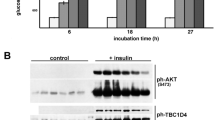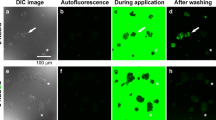Abstract
Mechanism and substrate specificity of the proton-coupled amino acid transporter 2 (PAT2, SLC36A2) have been studied so far only in heterologous expression systems such as HeLa cells and Xenopus laevis oocytes. In this study, we describe the identification of the first cell line that expresses PAT2. We cultured 3T3-L1 cells for up to 2 weeks and differentiated the cells into adipocytes in supplemented media containing 2 μM rosiglitazone. During the 14 day differentiation period the uptake of the prototype PAT2 substrate l-[3H]proline increased ~5-fold. The macro- and microscopically apparent differentiation of 3T3-L1 cells coincided with their H+ gradient-stimulated uptake of l-[3H]proline. Uptake was rapid, independent of a Na+ gradient but stimulated by an inwardly directed H+ gradient with maximal uptake occurring at pH 6.0. l-Proline uptake was found to be mediated by a transport system with a Michaelis constant (Kt) of 130 ± 10 μM and a maximal transport velocity of 4.9 ± 0.2 nmol × 5 min−1 mg of protein−1. Glycine, l-alanine, and l-tryptophan strongly inhibited l-proline uptake indicating that these amino acids also interact with the transport system. It is concluded that 3T3-L1 adipocytes express the H+-amino acid cotransport system PAT2.






Similar content being viewed by others
References
Bermingham JR Jr, Pennington J (2004) Organization and expression of the SLC36 cluster of amino acid transporter genes. Mamm Genome 15:114–125
Bermingham JR Jr, Shumas S, Whisenhunt T, Sirkowski EE, O’Connell S, Scherer SS, Rosenfeld MG (2002) Identification of genes that are downregulated in the absence of the POU domain transcription factor pou3f1 (Oct-6, Tst-1, SCIP) in sciatic nerve. J Neurosci 22:10217–10231
Boll M, Foltz M, Rubio-Aliaga I, Kottra G, Daniel H (2002) Functional characterization of two novel mammalian electrogenic proton-dependent amino acid cotransporters. J Biol Chem 277:22966–22973
Boll M, Foltz M, Anderson CMH, Oechsler C, Kottra G, Thwaites DT, Daniel H (2003a) Substrate recognition by the mammalian proton-dependent amino acid transporter PAT1. Mol Membr Biol 20:261–269
Boll M, Foltz M, Rubio-Aliaga I, Daniel H (2003b) A cluster of proton/amino acid transporter genes in the human and mouse genomes. Genomics 82:47–56
Boll M, Daniel H, Gasnier B (2004) The SLC36 family: proton-coupled transporters for the absorption of selected amino acids from extracellular and intracellular proteolysis. Pflügers Arch 447:776–779
Brandsch M (2006) Transport of l-proline, l-proline-containing peptides and related drugs at mammalian epithelial cell membranes. Amino Acids 31:119–136
Bröer S, Bailey CG, Kowalczuk S, Ng C, Vanslambrouck JM, Rodgers H, Auray-Blais C, Cavanaugh JA, Bröer A, Rasko JEJ (2008) Iminoglycinuria and hyperglycinuria are discrete human phenotypes resulting from complex mutations in proline and glycine transporters. J Clin Invest 118:3881–3892
Chen Z, Fei YJ, Anderson CMH, Wake KA, Miyauchi S, Huang W, Thwaites DT, Ganapathy V (2003a) Structure, function and immunolocalization of a proton-coupled amino acid transporter (hPAT1) in the human intestinal cell line Caco-2. J Physiol 546:349–361
Chen Z, Kennedy DJ, Wake KA, Zhuang L, Ganapathy V, Thwaites DT (2003b) Structure, tissue expression pattern, and function of the amino acid transporter rat PAT2. Biochem Biophys Res Commun 304:747–754
Edwards N, Anderson CMH, Gatfield KM, Jevons MP, Ganapathy V, Thwaites DT (2011) Amino acid derivatives are substrates or non-transported inhibitors of the amino acid transporter PAT2 (slc36a2). Biochim Biophys Acta 1808:260–270
Foltz M, Boll M, Raschka L, Kottra G, Daniel H (2004a) A novel bifunctionality: PAT1 and PAT2 mediate electrogenic proton/amino acid and electroneutral proton/fatty acid symport. FASEB J 18:1758–1760
Foltz M, Oechsler C, Boll M, Kottra G, Daniel H (2004b) Substrate specificity and transport mode of the proton-dependent amino acid transporter mPAT2. Eur J Biochem 271:3340–3347
Green H, Kehinde O (1974) Sublines of mouse 3T3 cells that accumulate lipid. Cell 1:113–116
Hediger MA (2004) The ABC of solute transporters. Pflügers Arch 447:5
Kennedy DJ, Gatfield KM, Winpenny JP, Ganapathy V, Thwaites DT (2005) Substrate specificity and functional characterisation of the H+/amino acid transporter rat PAT2 (Slc36a2). Br J Pharmacol 144:28–41
Klein C, Scoggin KE, Ealy AD, Troedsson MHT (2010) Transcriptional profiling of equine endometrium during the time of maternal recognition of pregnancy. Biol Reprod 83:102–113
Larsen M, Holm R, Jensen KG, Brodin B, Nielsen CU (2009) Intestinal gaboxadol absorption via PAT1 (SLC36A1): modified absorption in vivo following co-administration of l-tryptophan. Br J Pharmacol 157:1380–1389
Metzner L, Kalbitz J, Brandsch M (2004) Transport of pharmacologically active proline derivatives by the human proton-coupled amino acid transporter hPAT1. J Pharmacol Exp Ther 309:28–35
Metzner L, Kottra G, Neubert K, Daniel H, Brandsch M (2005) Serotonin, l-tryptophan, and tryptamine are effective inhibitors of the amino acid transport system PAT1. FASEB J 19:1468–1473
Metzner L, Neubert K, Brandsch M (2006) Substrate specificity of the amino acid transporter PAT1. Amino Acids 31:111–117
Pillai SM, Meredith D (2011) SLC36A4 (hPAT4) is a high affinity amino acid transporter when expressed in Xenopus laevis oocytes. J Biol Chem 286:2455–2460
Ranaldi G, Islam K, Sambuy Y (1994) D-cycloserine uses an active transport mechanism in the human intestinal cell line Caco 2. Antimicrob Agents Chemother 38:1239–1245
Rubio-Aliaga I, Boll M, Vogt-Weisenhorn DM, Foltz M, Kottra G, Daniel H (2004) The proton/amino acid cotransporter PAT2 is expressed in neurons with a different subcellular localization than its paralog PAT1. J Biol Chem 279:2754–2760
Sagné C, Agulhon C, Ravassard P, Darmon M, Hamon M, El Mestikawy S, Gasnier B, Giros B (2001) Identification and characterization of a lysosomal transporter for small neutral amino acids. Proc Natl Acad Sci USA 98:7206–7211
Sundberg BE, Wååg E, Jacobsson JA, Stephansson O, Rumaks J, Svirskis S, Alsiö J, Roman E, Ebendal T, Klusa V, Fredriksson R (2008) The evolutionary history and tissue mapping of amino acid transporters belonging to solute carrier families SLC32, SLC36, and SLC38. J Mol Neurosci 35:179–193
Thwaites DT, Anderson CMH (2007) Deciphering the mechanisms of intestinal imino (and amino) acid transport: the redemption of SLC36A1. Biochim Biophys Acta 1768:179–197
Thwaites DT, Anderson CM (2011) The SLC36 family of proton-coupled amino acid transporters and their potential role in drug transport. Br J Pharmacol 164:1802–1816
Thwaites DT, McEwan GTA, Cook MJ, Hirst BH, Simmons NL (1993) H+-coupled (Na+-independent) proline transport in human intestinal (Caco-2) epithelial cell monolayers. FEBS Lett 333:78–82
Thwaites DT, McEwan GTA, Simmons NL (1995) The role of the proton electrochemical gradient in the transepithelial absorption of amino acids by human intestinal Caco-2 cell monolayers. J Membr Biol 145:245–256
Vanslambrouck JM, Bröer A, Thavyogarajah T, Holst J, Bailey CG, Bröer S, Rasko JEJ (2010) Renal imino acid and glycine transport system ontogeny and involvement in developmental iminoglycinuria. Biochem J 428:397–407
Zebisch K, Voigt V, Wabitsch M, Brandsch M (2012) Protocol for effective differentiation of 3T3-L1 cells to adipocytes. Anal Biochem 425:88–90
Acknowledgments
This work was supported by the Deutsche Forschungsgemeinschaft grant # BR 2430/4-3. The authors thank Valerie Voigt for assistance in PCR measurements. This work will be part of the doctoral thesis of Katja Zebisch.
Conflict of interest
The authors declared no conflict of interest.
Ethical standards
The experiments comply with the current laws of the country in which they were performed.
Author information
Authors and Affiliations
Corresponding author
Rights and permissions
About this article
Cite this article
Zebisch, K., Brandsch, M. Transport of l-proline by the proton-coupled amino acid transporter PAT2 in differentiated 3T3-L1 cells. Amino Acids 44, 373–381 (2013). https://doi.org/10.1007/s00726-012-1340-9
Received:
Accepted:
Published:
Issue Date:
DOI: https://doi.org/10.1007/s00726-012-1340-9




